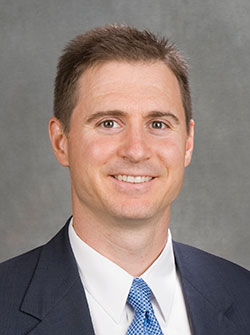ECON Corner: An interview with Dr. Joshua Lewer


Welcome to Peoria Magazine’s Econ Corner, a recurring feature in which we pose questions to experts about various economic issues and how they affect our lives and careers here in central Illinois. This month’s participant is Dr. Joshua Lewer, Chairman of the Department of Economics and McCord Professor of Executive Management Development at Bradley University.
PM: The economic headlines can sometimes be confusing for the average reader. On the one hand, the nation's economy reportedly is growing at the fastest pace in nearly 40 years. Job creation is up, with some 467,000 positions added in January. Wages are rising at a rate not seen since 2002. On the flip side, inflation is climbing at a clip not witnessed since Ronald Reagan was in his first term, the national debt just surpassed $30 trillion, the stock market has been on a roller coaster -- mostly downward of late -- and higher interest rates on borrowing seem to be looming.
Many Americans tend to view issues through a partisan lens these days, and the economy is no exception. Can you help us clarify matters? On balance, are most of us doing better, or worse?
JL: The U.S. economy continues to improve from the shortest recession on record that officially lasted two months and ended in April 2020. Since the shutdown, we have no doubt seen an uneven economy. So, are we in the aggregate doing better or worse? That's a multifaceted question because it really depends on what you are measuring against when comparing our pre-COVID-19 world with today.
Strictly from a GDP standpoint, the economy is in an expansion mode and the U.S. is adding jobs.
For example, according to the Bureau of Economic Analysis (BEA) most recent report, U.S. seasonally adjusted GDP was $23.9 trillion in the fourth quarter of 2021, compared to $21.4 trillion at the same time in 2020. Also, due to Federal Reserve expansionary monetary policies, broadly defined as "Quantitative Easing," most types of assets in the United States have seen significant appreciation over the last two years -- think equities and real estate -- causing the number of households to reach millionaire status to shoot to a record 22 million, according to Credit Suisse's Global Wealth Report 2021.
That being said, Americans in aggregate continue to have subdued and dimming expectations about their future, as reported by the University of Michigan’s most recent Consumer Sentiment Index. Other measures of the overall well-being of our citizenry have fallen dramatically.
One alarming statistic is that U.S. life expectancies are now falling. Princeton University economists Anne Case and Angus Deaton find that deaths of despair (DoD) such as suicide, drug overdoses and alcoholic liver disease are a major contributor to falling U.S. life expectancies. The misery experienced by our population from the C-19 pandemic and lockdown response is hard to quantify, but there can be no doubt that it has left a negative collective impact.
PM: What's your sense of how central Illinois' economy is faring relative to the rest of the country? What are our strengths? What are our weaknesses?
JL: My family moved to Peoria in 2007, right as the Great Recession was starting to take hold. Due to Peoria's high degree of manufacturing base relative to the whole economy, I was told by both Bradley and Caterpillar Inc. economists that our region generally lags both going into and coming out of a recession. For the most part, this is the case today.
For example, while the national unemployment rate had fallen to 4.0 percent as of January 2022, the Peoria five-county Metropolitan Statistical Area (MSA) unemployment rate was 4.4 percent as of December 2021. Look for the Peoria region to continue to see improving labor market conditions, especially when manufacturing supply chains begin to normalize.
While our region is experiencing continued population loss, I do see a concerted effort among the area's policymakers and leaders that makes me believe in a bright and prosperous future for the region.
For one, while corporate America continues to lose jobs, Peoria has focused on growing and expanding its small and local business footprint. This push is multifaceted and comes from a variety of sources including the Greater Peoria Economic Development Council (EDC), Bradley University's Small Business Development Center (SBDC) run by my colleague, Jim Foley, Caterpillar Inc.'s Supplier Diversity efforts, the Peoria Next Innovation Center, the Minority Business Development Center (MBDC), and the Illinois Manufacturing Excellence Center (IMEC), to name a few.
Recently, community leaders eyeing local labor mobility and quality of life initiatives began pursuing Amtrak passenger rail service for the Peoria area with access to Chicago. (See Peoria Mayor Rita Ali's press conference on the project.) While the impacts would still be a couple of years away, I wish success to all involved.
PM: No one has a crystal ball, of course, and the lingering pandemic makes the future even murkier. That said, would you venture an outlook on the rest of 2022, and what you think could be done (or not done) -- by the Federal Reserve, for instance, or by the U.S. Congress -- to help rather than hurt?
JL: Hall of Fame baseball player Yogi Berra once said, "Forecasting is very difficult, especially when it involves the future." I would have to agree with Yogi's statement, but among the tools economists can employ to provide some insight on economic activity and momentum are economic indicators.
Significant indicators such as the yield curve, money supply growth, ISM manufacturing PMI index, and housing starts, etc., suggest that barring some Black Swan event, the economy should continue to expand for at least the first half of 2022.
Alongside Mike Mahoney, a local fiduciary financial advisor, we provide baseline economic and financial forecasts on our educational YouTube Channel The Enlightened Investor. In a recent episode entitled "2022 Forecast: Crash, Boom, or Something Else?," our forecast was sandbagged with conservative estimates of stock market returns over the next 10 plus years, due to the higher-than-historical market returns of the last 13 years.
One more important note: It is an election year, so be prepared for fiscal stimulus out of Washington. These expansionary measures will serve as a short-run tailwind but will also raise national debt levels.

Mike Bailey is editor in
chief of Peoria Magazine.

